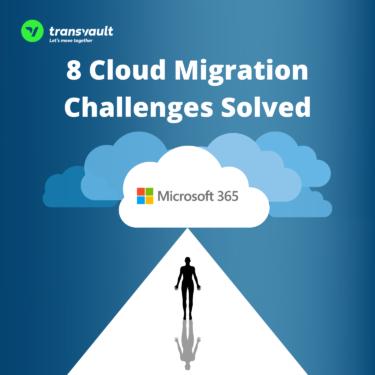Data Migration Planning – the ultimate guide

Innovation, modernisation and digitalisation are constants in the world of business. The goals of increasing efficiency, productivity and profitability underpin these business objectives.
As companies worldwide continue their path towards digitalisation, many have data migrations at the top of their priority list.
No two data migration projects are identical, as companies have varying requirements and existing data architectures. Knowing the right data migration approach for your business and investing the time to ensure you have implemented it correctly is crucial for success.
This blog examines the following:
- Different types of data migration plans
- How to successfully implement a changeover
- Important things to consider on your journey
With nearly two decades of successful migration projects under its belt, Transvault understands the complex challenges businesses face when undertaking these types of tasks. This ultimate guide to data migration will help you through the process and ensure you’ve checked all the boxes.
Navigating our data migration planning guide
It’s important to be fully prepared for a data migration project and that’s why our guide is comprehensive. In order to best navigate it, click on the below links to jump to the most relevant section:
Why should I migrate my data?
Depending on business objectives, the reasons for data migration vary. Some of the most frequently cited reasons include:
- Digital transformations – Cloud migration
- Mergers and acquisitions
- Replacing or updating outdated or legacy software, hardware and applications
- Centralising data for organisation-wide use
- Regulatory compliance
- Enhanced performance and processing speeds
- Cost efficiency
- Business process changes
- Data volume growth
- Easier scalability
- Sustainability initiatives
No matter the reasoning behind a data migration project, it’s essential that the process is smooth and the solution is fit for purpose.
Data migrations as part of digital transformation
The world is increasingly digital, and digital transformations happen rapidly in today’s fast-paced business environment.
Part of digital transformation is adopting new and emerging technologies and optimising existing business processes and systems. Data migrations are a vital component of this process.
How does data migration help support digital transformations?
- Optimised data quality
Data migrations enable businesses to cleanse existing data. It helps maintain integrity, improves data quality and accuracy and aids in decision-making. Also, by cleansing their data before migration, organisations can significantly reduce the overall cost of their digital transformation by only moving the data they need to in order to remain compliant.
- Faster technology adoption
Data migration assists in the adoption of emerging technologies by enabling companies to take advantage of new platforms without the risk of losing data, historical analytics, or insights.
- Cost efficiency
Rising costs, supply chain disruptions and soaring interest rates have businesses scrutinising every cent they spend. Outdated legacy systems and inefficient processes can increase costs significantly. Migrating to private or public clouds or new platforms and technologies improves efficiency and decreases overheads.
- Improved security
Data protection is a global concern, and securing your data is paramount. Data migration projects enable security upgrades and help protect against rising cybersecurity threats.
- Enhanced performance
Better performance means increased efficiency and profitability. Moving to new platforms can help enhance business system and application performance, facilitating enhanced user experience and streamlined growth.
- Achieve data compliance
Compliance with data protection laws, such as CCPA, is necessary for any organisation that collects, processes, or stores personal data. By migrating data to compliant platforms, companies can ensure that they are adhering to data protection regulations and avoiding potential legal liabilities and financial penalties.
Data Migrations in Mergers and Acquisitions (M&As), and Divestitures
Data migration can play a crucial role in M&As by facilitating the integration of two separate entities into one cohesive organisation, or vice versa for divestitures. Often, the main objective of an M&A is growth.
Here are a few ways in which a data migration project can help facilitate this:
Consolidation of data
During M&A, the two companies may have different systems and data structures. A data migration project can consolidate the data from both businesses into a single system, creating a unified view of organisational data.
Efficient data management
By consolidating data, migration can streamline the data management process. It reduces the risk of errors and makes accessing and analysing the data easier.
Cost savings
Data migration can help reduce costs associated with maintaining multiple data systems. Data consolidation enables organisations to reduce the number of licences, maintenance costs and resources required to manage data.
Improved decision making
A data migration project gives decision-makers a comprehensive view of combined organisational data. It improves decision-making by delivering better operational insights.
Smoother transition
A data migration project helps ensure a smooth transition between the merging companies. Employees can quickly become familiar with new systems and processes by providing a unified view of organisational data.
Data migrations due to End-of-life and legacy systems
End-of-life and legacy systems are encountered by all businesses at one point or another – especially as new and emerging technologies become available. Data migration can help transition from these systems in several ways:
Data preservation
Legacy systems often contain valuable data that may be difficult or impossible to recreate. Data migration ensures this data is preserved and accessed in the future.
Maintenance cost reduction
End-of-life and legacy systems are often expensive to maintain due to the need for specialised expertise, outdated hardware or software and the risk of downtime from hardware failure. Organisations can reduce maintenance costs and improve system performance by migrating data to a newer system or a cloud-based infrastructure.
Ensures compliance
Legacy systems may no longer comply with industry or regulatory standards. Data migration and modernisation can help ensure compliance and reduce the risk of penalties or legal action.
Improved efficiency
End-of-life systems are often slow and inefficient, potentially impacting productivity and business operations. Updating data migration systems can improve efficiency and allow organisations to take advantage of new technology and enhanced features.
Enhanced security
Legacy systems often have vulnerabilities that cybercriminals could exploit. Organisations can reduce data breaches and other security risks by migrating data to modern systems with better security features.
Benefits of data migration
We’ve discussed many benefits of migrating data to newer, more modern systems. It can be beneficial in other ways as well, including:
Business agility
Organisations can adapt quickly to changing business needs and market conditions by migrating data to a more flexible and scalable infrastructure.
Better decision-making
Data migration helps companies consolidate and standardise data, making it easier to analyse and gain insights for better decision-making.
Disaster recovery
Data migration enables organisations to recreate more robust disaster recovery and business continuity plans by replicating critical data to multiple locations. It can ensure no, or at least shorter, downtimes in crisis.
Collaboration
Successful data migration can help businesses improve collaboration among teams by providing better access to data and enabling more straightforward sharing across departments and locations.
Planning an email data migration?
Our specialist team are ready to help
When should I migrate my data?
You may need to move your data from one system to another for several reasons. Consider the following:
Upgrading or replacing systems
When a business needs to replace or modernise software, hardware or operating systems, it may need to migrate its data. This process ensures data is accessible and usable in new environments.
Consolidating systems
A business with multiple systems or databases containing redundant or overlapping data may consolidate them into a single system. This process simplifies management and improves efficiency.
Moving to the Cloud
Known as Cloud migration, many businesses are opting for this transition for cost savings, scalability and improved accessibility. It may involve migrating data from on-premises systems to cloud platforms, such as Amazon Web Services (AWS), Microsoft 365 or Google Cloud Platform.
Compliance or regulatory requirements
Businesses may need to migrate their data to comply with changing regulatory or legal requirements. These can include:
- Data protection and privacy laws
- Retention policies
- Security standards
- Business expansion
When a business expands into new markets or locations, it may need to migrate data to ensure it’s available to all customers and employees in the new area.
Overall, businesses should consider migrating their data when necessary to ensure it remains accessible, secure and usable in changing business environments.
Data migration types
There are several types of data migrations that organisations may undergo to move data from one system to another. It’s important to remember that these processes are fluid, and each comes with a unique set of challenges and considerations.
Data migration to the cloud
Cloud-based storage solutions offer organisations a cost-effective and scalable way to store, process, and manage large amounts of data. By migrating data to the cloud, organisations can benefit from improved data security, accessibility, and flexibility.
Data migration from on-premises to the cloud
This type of data migration project involves moving data from servers that sit on-premises to a cloud-based environment.
Moving to cloud-based infrastructures achieves several goals, including:
- Infinite scalability
- Improved flexibility
- Reduced infrastructure and IT costs
- Faster provisioning
- Effortless upgrading
- Rapid technology adoption and innovation
Tenant-to-Tenant
What is a tenant?
A tenant is a logical grouping of an organisation’s users, data and resources within an application or service. An excellent example of this is Microsoft 365 or Google Workspace.
Why move tenant to tenant?
There may be several instances of a tenant running in an organisation – such as in an M&A or moving away from your current tenant to another that better meets your business needs.
What are the benefits of a tenant-to-tenant migration?
- Effective collaboration
- Simple licencing
- Easy account replication
- Easy and secure management of workloads
Moving tenant-to-tenant could require some downtime and would significantly impact users. Organizations generally perform this type of data migration over a weekend with a direct swap or parallel operations until the full migration is complete.
Find out more about Transvault’s tenant to tenant service for Microsoft 365 and Google Workspace.
Cloud repatriation migrations
Why move from the cloud to an on-premises solution?
There are many reasons businesses migrate back to on-premises storage solutions, including:
- Variable performance – Public cloud performance depends on available bandwidth and the cloud provider’s workload. In some instances, it can negatively impact business performance.
- Vendor dependency – Becoming overly dependent on your cloud provider is often a business red flag. Moving to another could prove challenging if an organisation has built its entire system into its cloud provider. Many businesses are finding single vendors charging more for the same services.
- Data control and security – Decentralised configuration management introduces security risks. On-premises solutions have consolidated management and clearly defined parameters – offering greater control and data security.
Other migration types:
Storage migrations
This type of data migration project involves moving data from one storage system to another.
It may be necessary when storage infrastructures become outdated or the business requires additional capacity.
Database migrations
Database migration is as it sounds – moving from one database to another.
It happens when businesses require more features and functionality or when their existing databases reach end-of-life.
Data migration approaches and strategies
There isn’t a one-size-fits-all approach to data migration. Depending on your business requirements, several methods and strategies are available to fit your needs.
Big bang migration
In this data migration approach, a company moves all its data to the new system at once. It can be faster and less disruptive than other approaches but also carries a higher risk of failure and data corruption or loss.
Phased or ‘trickle’ migration
The phased or trickle migration approach involves moving data in stages. It may include moving different departments or functions to a new system over time instead of all at once. This process can reduce the disruption risk and allow more testing and validation time.
Parallel migration
In this approach, businesses run the old and new systems in parallel – as discussed in the tenant-to-tenant section. It involves migrating data gradually from the old system to the new one. It provides a safety net in case of problems in the new system but can also be more complex and time-consuming.
Selective migration
Selective migration involves migrating only a subset of data to a new system. A good example of this is when organisations move their most critical or frequently used data. This process can be quicker and less disruptive than other approaches but can also result in data inconsistencies if not done carefully.
Hybrid migration
Hybrid migration involves using a combination of migration strategies. For instance, businesses may use a phased migration followed by parallel migration. This data migration approach provides all the benefits of the methods employed while mitigating the risks.
Key considerations for data migrations
Before undertaking any data migration project, it’s vital to have a plan in place to ensure your data migration is safe and accurate. Here are a few things to consider before implementing data migration:
- Define the scope – Determine the project’s scope and identify any data that needs migrating. This includes:
- Defining the source
- Defining the destination
- Determining the data types e.g., email, SharePoint, Teams
- Determining the data volume
2. Develop a plan – Create a detailed plan that outlines your migration process. Your plan should include the following:
- Timeline for progression
- Milestones
- Resource list
- Contingency plan (in case of unexpected issues)
3. Security and compliance – Ensure your business meets data security and compliance prior to and during migration. You must consider protecting sensitive data and complying with all data privacy regulations.
4. Data quality assessment – Assess your data quality before migration. Identify any quality issues and develop a plan to address them. This process may include data cleansing or enrichment, guaranteeing data is accurate, complete and consistent.
5. Data mapping – Develop a data mapping plan that identifies the fields and data elements that will be part of the migration. This process ensures data is transferred accurately and without errors.
6. Data validation – Develop a data validation plan, including testing and validation of migrated data. This process ensures you migrate data thoroughly and accurately.
7. Communication plan – Develop a communication plan to inform stakeholders of the project’s progress. This includes identifying key stakeholders and their communication requirements and providing regular updates.
8. User training and support – Provide training and support to end-users to ensure they understand how to use the new system and access the migrated data.
9. Post-migration support – Develop a plan to provide support after migration completion. This includes monitoring the new system to ensure it’s working as expected and to allow you to address any issues that arise quickly.
The importance of assessing and cleansing your data
The cleanse phase is an integral part of the project. It involves ensuring data is identified, cleaned and transformed to ensure accuracy, completeness and consistency.
This phase’s goal is to ensure that migrated data is free of errors, duplicates and other issues that could affect the project’s overall success. The cleanse phase of a data migration project should include the following:
Identify data quality issues
Identify inaccurate, incomplete or inconsistent data. Businesses can use data profiling tools to analyse existing data for issues.
Develop a data cleansing plan
Once you’ve identified any data quality issues, develop a plan to clean the data. The plan may include error corrections, filling in missing data and removing duplicates.
Execute data cleansing
There are various ways to approach data cleansing. For example, implementing data validation rules to correct and identify errors and data transformation tools can be used to convert data into your desired format.
Validate cleansed data
Once cleansed, businesses should validate data to ensure the migration process has improved its quality. You can do this using data profiling and other data quality metrics.
Fully document the data cleansing process
Over the lifetime of your business, you may employ several data migration projects. Documenting the data cleansing process is an essential future reference. This documentation can include the following:
- Details about the data quality issues identified
- Data cleansing plan
- Tools and techniques used for cleansing
Data migration roles and responsibilities
It’s essential to be clear about the roles and responsibilities of those included in the project to ensure a seamless transition between data platforms. Doing this makes sure the project runs smoothly, and nothing slips through the cracks. Keep in mind, depending on the scope of your project; businesses may combine some of these roles – or additional roles may be required.
Project Manager
The project manager oversees the entire data migration project and is responsible for ensuring the project is completed on time and within budget. They are also responsible for identifying and managing risks and communicating progress and issues to stakeholders.
Business Analyst
The business analyst is responsible for understanding the project’s business requirements. They work with stakeholders to define data migration rules, perform data mapping and maintain data quality throughout the project.
Data Analyst
The data analyst is responsible for analysing the data to be migrated. They must ensure data is clean, accurate and complete. They may also be responsible for developing scripts to transform data formats.
Data Engineer
Migration engineers are responsible for designing and implementing the data migration process. They may also develop data models, design data pipelines, and optimise data transfer speeds.
IT Administrator
The IT administrator is responsible that the infrastructure is in place to support the data migration process. They may also ensure data is transferred securely and efficiently by overseeing server, networks and storage system configuration.
Quality Assurance (QA) Analyst
The QA Analyst is responsible for testing the data migration process and making sure it proceeds without errors. They may also develop test plans, execute test cases and report defects or bugs in the system.
Data Steward
The data steward must ensure the data is consistent, accurate and meets the company’s data quality standards. They may also be responsible for data validation after migration and confirming that it is integrated with other systems as required.
Change Management Specialist
A change management specialist manages possible required organisational changes for a data migration project. They may also communicate changes to stakeholders, develop training materials, and provide transition support.
Data migration software
For most data migration projects, you will need some sort of migration software, and it’s important to pick the right software for the job. Transvault has designed its software to streamline your email archive data migration project, ensuring it’s: Secure, robust, adaptable and extensible. We have delivered over 3,000+ migrations for customers across 56 countries worldwide using our software and services
.
Here are two of our solutions to help you implement a successful data migration:
Transvault’s Migrator software provides a tried, trusted, compliant method to migrate enterprise email archives. It works with on-premises and cloud proprietary archive platforms, services and appliances, inc Microsoft 365.
If you’re operating an SME or have a smaller data volume, Transvault’s Sprint software provides a seamless, cost-effective way to migrate legacy email archives to Microsoft 365 from; Enterprise Vault (EV) and Enterprise Archive Solution (EAS)
Data migration best practices
Data migration projects are complex and require careful planning to ensure transferred data is accurate and secure. To guarantee success, we suggest considering the following best practices:
Define clear goals and objectives:
Before you start the data migration project, clearly define your goals and objectives. Understand why you are migrating your data and what you hope to achieve.
Create a detailed project plan:
Your detailed data migration project plan should outline all required tasks, timelines and resources. Be sure to identify potential risks and how to mitigate them.
Perform a data inventory and cleanse:
Conduct a thorough data inventory and clean up before migration. This process includes identifying and eliminating duplicate, outdated or irrelevant data.
Test the migration process:
Simulate the migration process within a test environment to identify issues and ensure an accurate migration.
Secure the data:
Ensure data is secure throughout the migration process using encryption and best practices for data security and privacy.
Staff training and education:
Train staff on how to use the new system. Ensure they understand the new data structures and formats.
Develop a backup and recovery plan:
This plan ensures you can recover data in case of any unexpected issues or data loss.
Transvault – data migration specialists
In this article, we’ve explored the different data migration strategies and approaches, including best practices. There are several considerations in migration projects, but with our unique experience and a network of specialist migration partners, you can trust Transvault to deliver your successful email archive data migration.
Planning an email archive data migration?
Our specialist team are ready to help
Relevant resources

How to plan a Microsoft Office 365 email migration
Microsoft Office 365 email migrations are anything but easy. They require a clear Microsoft Office 365 migration plan and a concrete strategy if your migration is going to be deemed a success. Now it’s not all doom and gloom because we’re here to help make your migration to the cloud simple.
Read more – How to plan a Microsoft Office 365 email migration

Cut business costs by migrating your email archive now
With challenging economic conditions, it’s understandable that some businesses are considering their spending until they have a more certain future. However, when it comes to spending on IT projects, such as migrating an email archive to the cloud, pausing may not be the best strategy.
In this blog we explore your options around an email archive migration and the potential cost implications of each of these options.
Read more – Cut business costs by migrating your email archive now
